University Project: MyHousing System, Housing NSW Project Management
VerifiedAdded on 2022/08/29
|8
|1599
|29
Project
AI Summary
This document presents a comprehensive project management analysis of the "MyHousing" system for Housing NSW. It begins with a problem description highlighting the agency's challenges in managing customer records and the limitations of manual data handling. The document then outlines the system's capabilities, which include online application submission, account management, and access to support services. It details the business benefits, such as reduced IT costs, scalability, and improved collaboration efficiency. A stakeholder map identifies key stakeholders and their levels of interest and influence. The document also explores the project's feasibility, including technical and operational aspects, and discusses potential risks like project delays and cost overruns. The references cited support the information provided in the document.
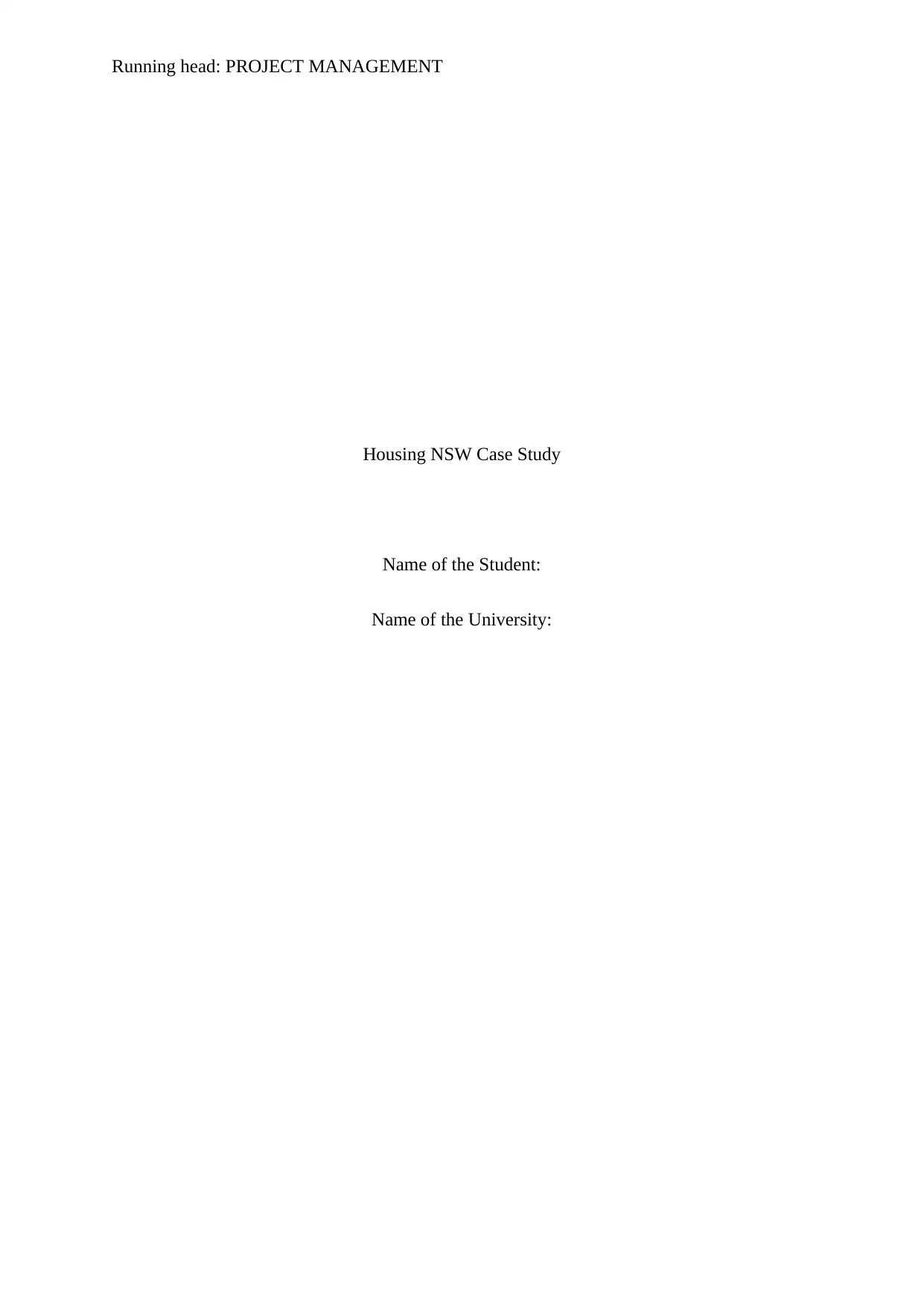
Running head: PROJECT MANAGEMENT
Housing NSW Case Study
Name of the Student:
Name of the University:
Housing NSW Case Study
Name of the Student:
Name of the University:
Paraphrase This Document
Need a fresh take? Get an instant paraphrase of this document with our AI Paraphraser
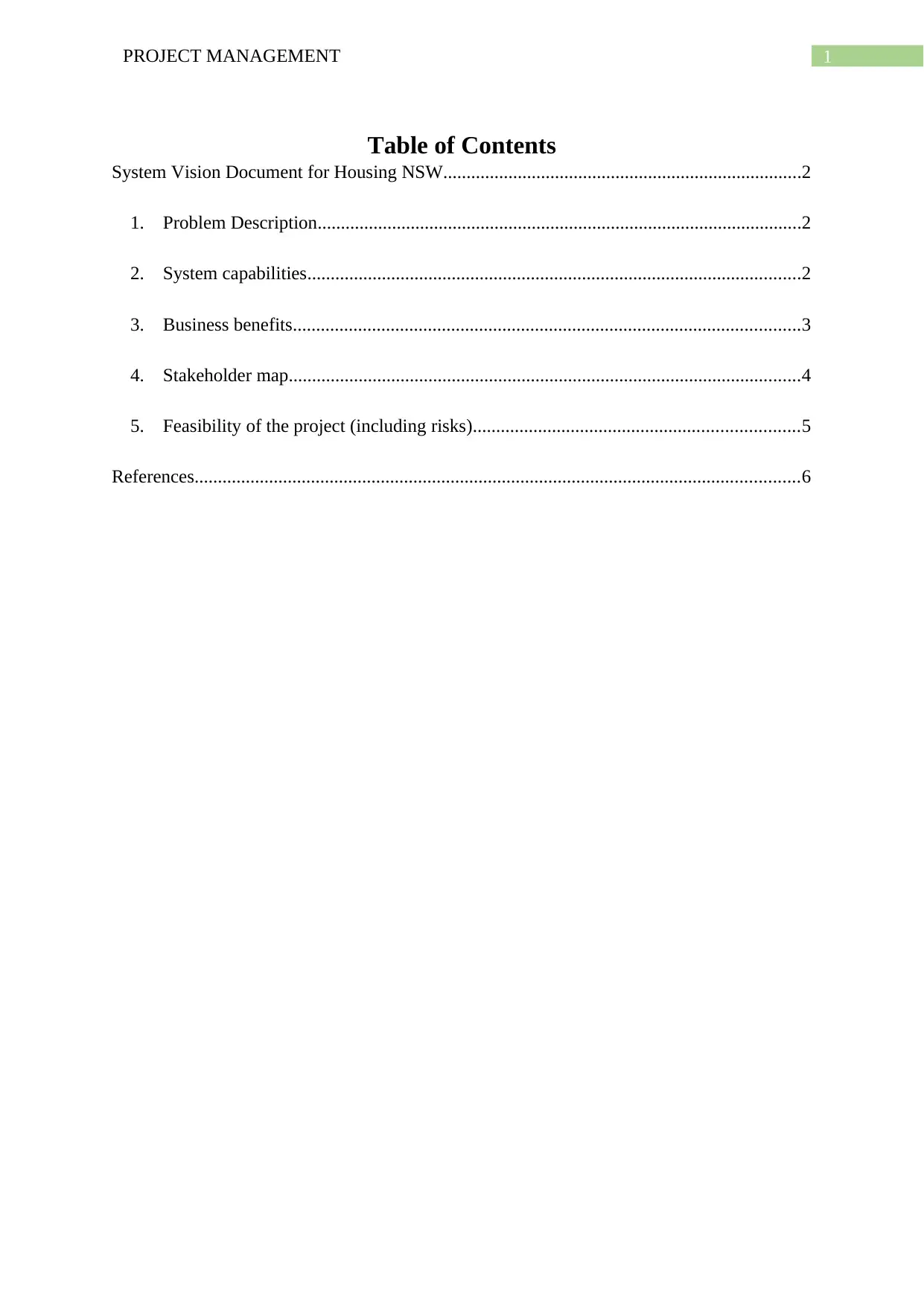
1PROJECT MANAGEMENT
Table of Contents
System Vision Document for Housing NSW.............................................................................2
1. Problem Description........................................................................................................2
2. System capabilities..........................................................................................................2
3. Business benefits.............................................................................................................3
4. Stakeholder map..............................................................................................................4
5. Feasibility of the project (including risks)......................................................................5
References..................................................................................................................................6
Table of Contents
System Vision Document for Housing NSW.............................................................................2
1. Problem Description........................................................................................................2
2. System capabilities..........................................................................................................2
3. Business benefits.............................................................................................................3
4. Stakeholder map..............................................................................................................4
5. Feasibility of the project (including risks)......................................................................5
References..................................................................................................................................6
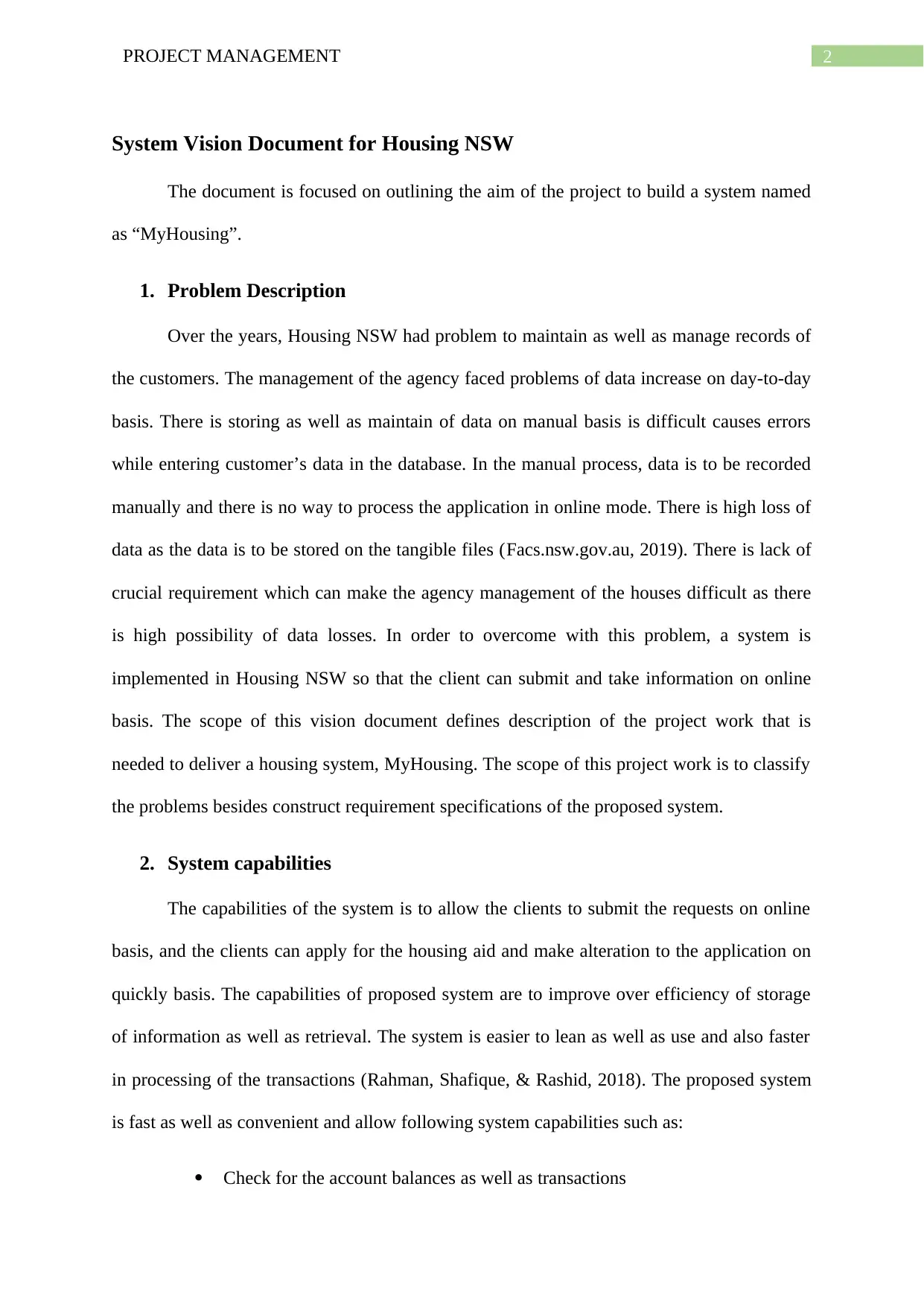
2PROJECT MANAGEMENT
System Vision Document for Housing NSW
The document is focused on outlining the aim of the project to build a system named
as “MyHousing”.
1. Problem Description
Over the years, Housing NSW had problem to maintain as well as manage records of
the customers. The management of the agency faced problems of data increase on day-to-day
basis. There is storing as well as maintain of data on manual basis is difficult causes errors
while entering customer’s data in the database. In the manual process, data is to be recorded
manually and there is no way to process the application in online mode. There is high loss of
data as the data is to be stored on the tangible files (Facs.nsw.gov.au, 2019). There is lack of
crucial requirement which can make the agency management of the houses difficult as there
is high possibility of data losses. In order to overcome with this problem, a system is
implemented in Housing NSW so that the client can submit and take information on online
basis. The scope of this vision document defines description of the project work that is
needed to deliver a housing system, MyHousing. The scope of this project work is to classify
the problems besides construct requirement specifications of the proposed system.
2. System capabilities
The capabilities of the system is to allow the clients to submit the requests on online
basis, and the clients can apply for the housing aid and make alteration to the application on
quickly basis. The capabilities of proposed system are to improve over efficiency of storage
of information as well as retrieval. The system is easier to lean as well as use and also faster
in processing of the transactions (Rahman, Shafique, & Rashid, 2018). The proposed system
is fast as well as convenient and allow following system capabilities such as:
Check for the account balances as well as transactions
System Vision Document for Housing NSW
The document is focused on outlining the aim of the project to build a system named
as “MyHousing”.
1. Problem Description
Over the years, Housing NSW had problem to maintain as well as manage records of
the customers. The management of the agency faced problems of data increase on day-to-day
basis. There is storing as well as maintain of data on manual basis is difficult causes errors
while entering customer’s data in the database. In the manual process, data is to be recorded
manually and there is no way to process the application in online mode. There is high loss of
data as the data is to be stored on the tangible files (Facs.nsw.gov.au, 2019). There is lack of
crucial requirement which can make the agency management of the houses difficult as there
is high possibility of data losses. In order to overcome with this problem, a system is
implemented in Housing NSW so that the client can submit and take information on online
basis. The scope of this vision document defines description of the project work that is
needed to deliver a housing system, MyHousing. The scope of this project work is to classify
the problems besides construct requirement specifications of the proposed system.
2. System capabilities
The capabilities of the system is to allow the clients to submit the requests on online
basis, and the clients can apply for the housing aid and make alteration to the application on
quickly basis. The capabilities of proposed system are to improve over efficiency of storage
of information as well as retrieval. The system is easier to lean as well as use and also faster
in processing of the transactions (Rahman, Shafique, & Rashid, 2018). The proposed system
is fast as well as convenient and allow following system capabilities such as:
Check for the account balances as well as transactions
⊘ This is a preview!⊘
Do you want full access?
Subscribe today to unlock all pages.

Trusted by 1+ million students worldwide
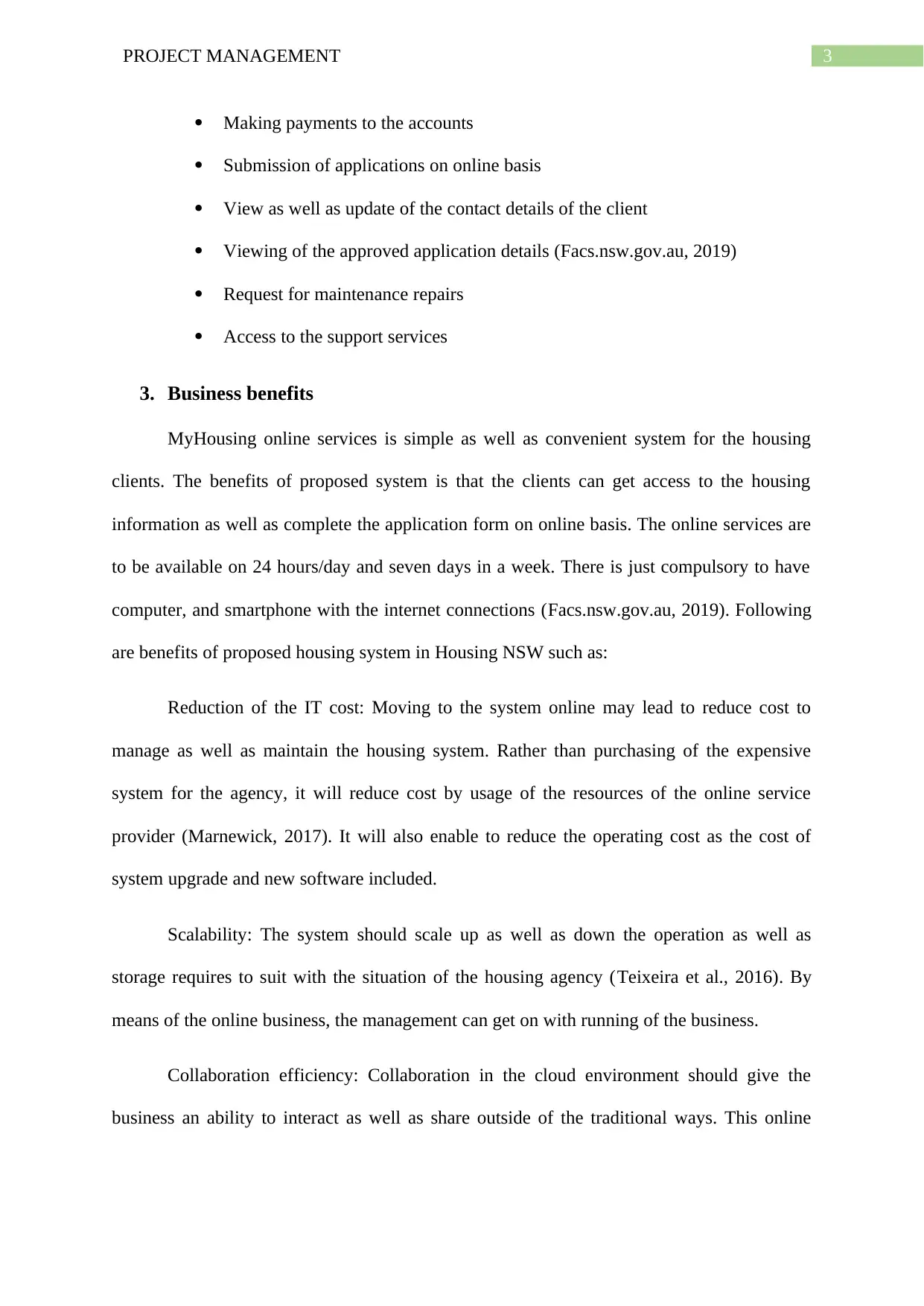
3PROJECT MANAGEMENT
Making payments to the accounts
Submission of applications on online basis
View as well as update of the contact details of the client
Viewing of the approved application details (Facs.nsw.gov.au, 2019)
Request for maintenance repairs
Access to the support services
3. Business benefits
MyHousing online services is simple as well as convenient system for the housing
clients. The benefits of proposed system is that the clients can get access to the housing
information as well as complete the application form on online basis. The online services are
to be available on 24 hours/day and seven days in a week. There is just compulsory to have
computer, and smartphone with the internet connections (Facs.nsw.gov.au, 2019). Following
are benefits of proposed housing system in Housing NSW such as:
Reduction of the IT cost: Moving to the system online may lead to reduce cost to
manage as well as maintain the housing system. Rather than purchasing of the expensive
system for the agency, it will reduce cost by usage of the resources of the online service
provider (Marnewick, 2017). It will also enable to reduce the operating cost as the cost of
system upgrade and new software included.
Scalability: The system should scale up as well as down the operation as well as
storage requires to suit with the situation of the housing agency (Teixeira et al., 2016). By
means of the online business, the management can get on with running of the business.
Collaboration efficiency: Collaboration in the cloud environment should give the
business an ability to interact as well as share outside of the traditional ways. This online
Making payments to the accounts
Submission of applications on online basis
View as well as update of the contact details of the client
Viewing of the approved application details (Facs.nsw.gov.au, 2019)
Request for maintenance repairs
Access to the support services
3. Business benefits
MyHousing online services is simple as well as convenient system for the housing
clients. The benefits of proposed system is that the clients can get access to the housing
information as well as complete the application form on online basis. The online services are
to be available on 24 hours/day and seven days in a week. There is just compulsory to have
computer, and smartphone with the internet connections (Facs.nsw.gov.au, 2019). Following
are benefits of proposed housing system in Housing NSW such as:
Reduction of the IT cost: Moving to the system online may lead to reduce cost to
manage as well as maintain the housing system. Rather than purchasing of the expensive
system for the agency, it will reduce cost by usage of the resources of the online service
provider (Marnewick, 2017). It will also enable to reduce the operating cost as the cost of
system upgrade and new software included.
Scalability: The system should scale up as well as down the operation as well as
storage requires to suit with the situation of the housing agency (Teixeira et al., 2016). By
means of the online business, the management can get on with running of the business.
Collaboration efficiency: Collaboration in the cloud environment should give the
business an ability to interact as well as share outside of the traditional ways. This online
Paraphrase This Document
Need a fresh take? Get an instant paraphrase of this document with our AI Paraphraser
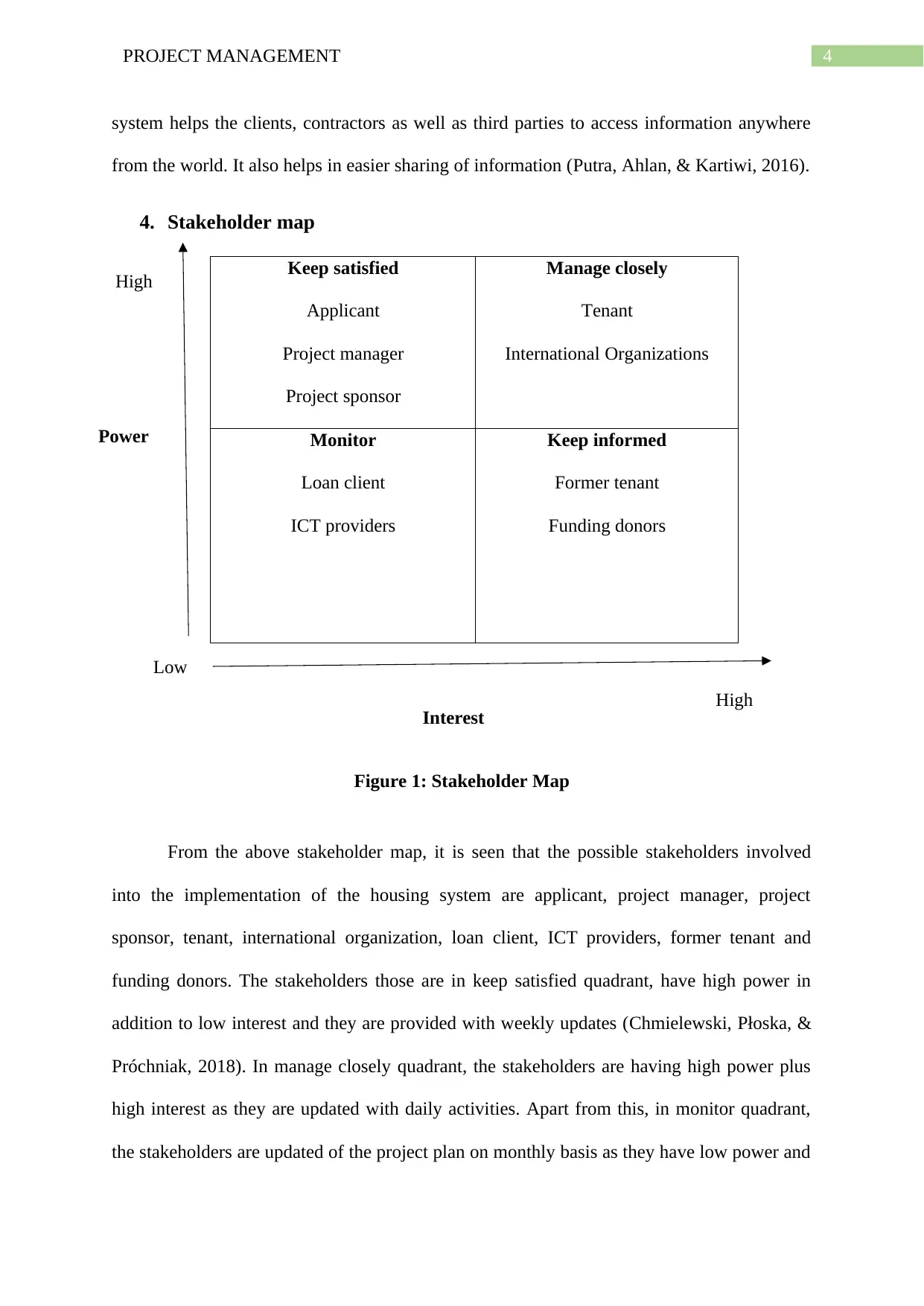
4PROJECT MANAGEMENT
system helps the clients, contractors as well as third parties to access information anywhere
from the world. It also helps in easier sharing of information (Putra, Ahlan, & Kartiwi, 2016).
4. Stakeholder map
Keep satisfied
Applicant
Project manager
Project sponsor
Manage closely
Tenant
International Organizations
Monitor
Loan client
ICT providers
Keep informed
Former tenant
Funding donors
Figure 1: Stakeholder Map
From the above stakeholder map, it is seen that the possible stakeholders involved
into the implementation of the housing system are applicant, project manager, project
sponsor, tenant, international organization, loan client, ICT providers, former tenant and
funding donors. The stakeholders those are in keep satisfied quadrant, have high power in
addition to low interest and they are provided with weekly updates (Chmielewski, Płoska, &
Próchniak, 2018). In manage closely quadrant, the stakeholders are having high power plus
high interest as they are updated with daily activities. Apart from this, in monitor quadrant,
the stakeholders are updated of the project plan on monthly basis as they have low power and
High
Power
Low
High
Interest
system helps the clients, contractors as well as third parties to access information anywhere
from the world. It also helps in easier sharing of information (Putra, Ahlan, & Kartiwi, 2016).
4. Stakeholder map
Keep satisfied
Applicant
Project manager
Project sponsor
Manage closely
Tenant
International Organizations
Monitor
Loan client
ICT providers
Keep informed
Former tenant
Funding donors
Figure 1: Stakeholder Map
From the above stakeholder map, it is seen that the possible stakeholders involved
into the implementation of the housing system are applicant, project manager, project
sponsor, tenant, international organization, loan client, ICT providers, former tenant and
funding donors. The stakeholders those are in keep satisfied quadrant, have high power in
addition to low interest and they are provided with weekly updates (Chmielewski, Płoska, &
Próchniak, 2018). In manage closely quadrant, the stakeholders are having high power plus
high interest as they are updated with daily activities. Apart from this, in monitor quadrant,
the stakeholders are updated of the project plan on monthly basis as they have low power and
High
Power
Low
High
Interest
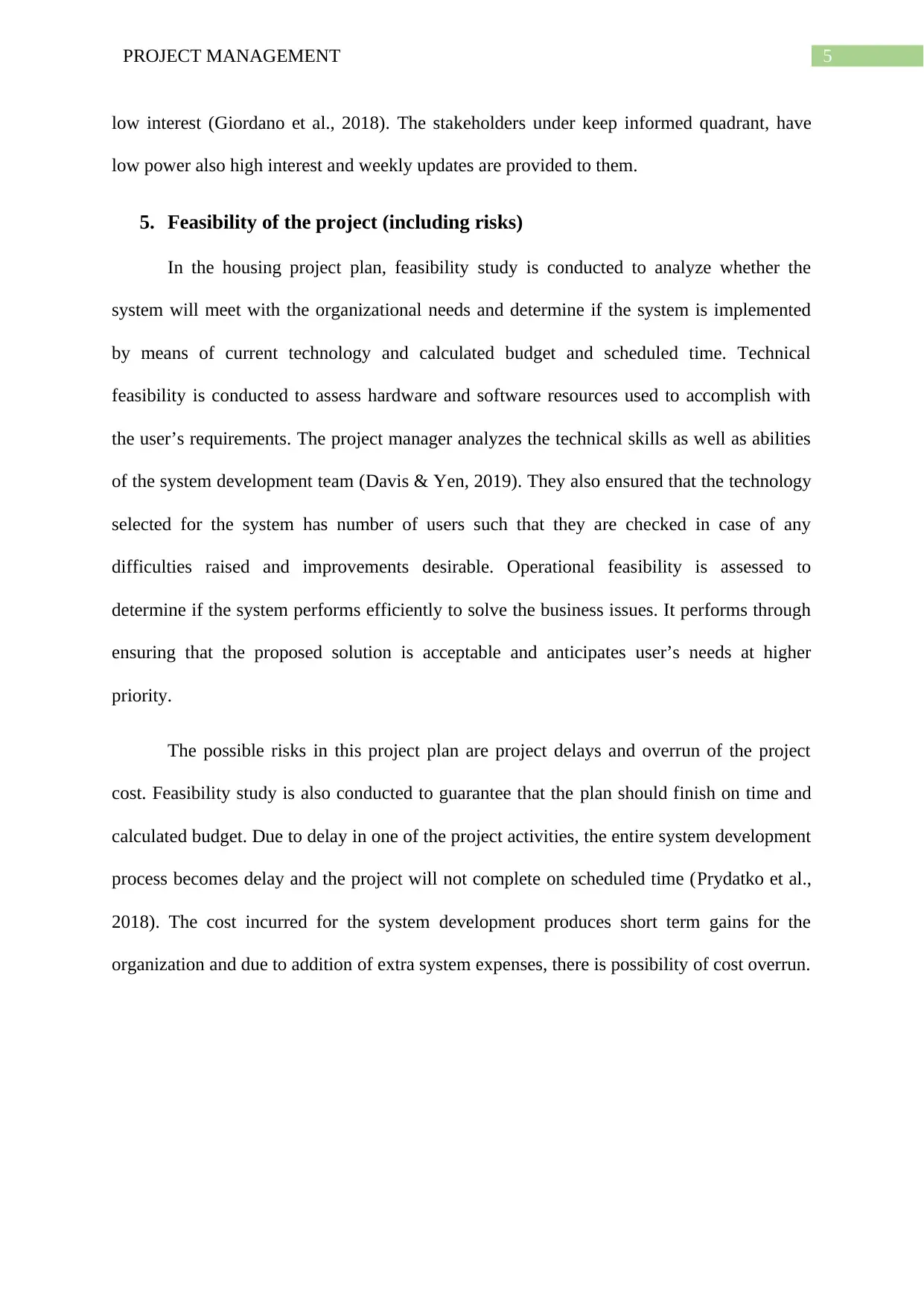
5PROJECT MANAGEMENT
low interest (Giordano et al., 2018). The stakeholders under keep informed quadrant, have
low power also high interest and weekly updates are provided to them.
5. Feasibility of the project (including risks)
In the housing project plan, feasibility study is conducted to analyze whether the
system will meet with the organizational needs and determine if the system is implemented
by means of current technology and calculated budget and scheduled time. Technical
feasibility is conducted to assess hardware and software resources used to accomplish with
the user’s requirements. The project manager analyzes the technical skills as well as abilities
of the system development team (Davis & Yen, 2019). They also ensured that the technology
selected for the system has number of users such that they are checked in case of any
difficulties raised and improvements desirable. Operational feasibility is assessed to
determine if the system performs efficiently to solve the business issues. It performs through
ensuring that the proposed solution is acceptable and anticipates user’s needs at higher
priority.
The possible risks in this project plan are project delays and overrun of the project
cost. Feasibility study is also conducted to guarantee that the plan should finish on time and
calculated budget. Due to delay in one of the project activities, the entire system development
process becomes delay and the project will not complete on scheduled time (Prydatko et al.,
2018). The cost incurred for the system development produces short term gains for the
organization and due to addition of extra system expenses, there is possibility of cost overrun.
low interest (Giordano et al., 2018). The stakeholders under keep informed quadrant, have
low power also high interest and weekly updates are provided to them.
5. Feasibility of the project (including risks)
In the housing project plan, feasibility study is conducted to analyze whether the
system will meet with the organizational needs and determine if the system is implemented
by means of current technology and calculated budget and scheduled time. Technical
feasibility is conducted to assess hardware and software resources used to accomplish with
the user’s requirements. The project manager analyzes the technical skills as well as abilities
of the system development team (Davis & Yen, 2019). They also ensured that the technology
selected for the system has number of users such that they are checked in case of any
difficulties raised and improvements desirable. Operational feasibility is assessed to
determine if the system performs efficiently to solve the business issues. It performs through
ensuring that the proposed solution is acceptable and anticipates user’s needs at higher
priority.
The possible risks in this project plan are project delays and overrun of the project
cost. Feasibility study is also conducted to guarantee that the plan should finish on time and
calculated budget. Due to delay in one of the project activities, the entire system development
process becomes delay and the project will not complete on scheduled time (Prydatko et al.,
2018). The cost incurred for the system development produces short term gains for the
organization and due to addition of extra system expenses, there is possibility of cost overrun.
⊘ This is a preview!⊘
Do you want full access?
Subscribe today to unlock all pages.

Trusted by 1+ million students worldwide
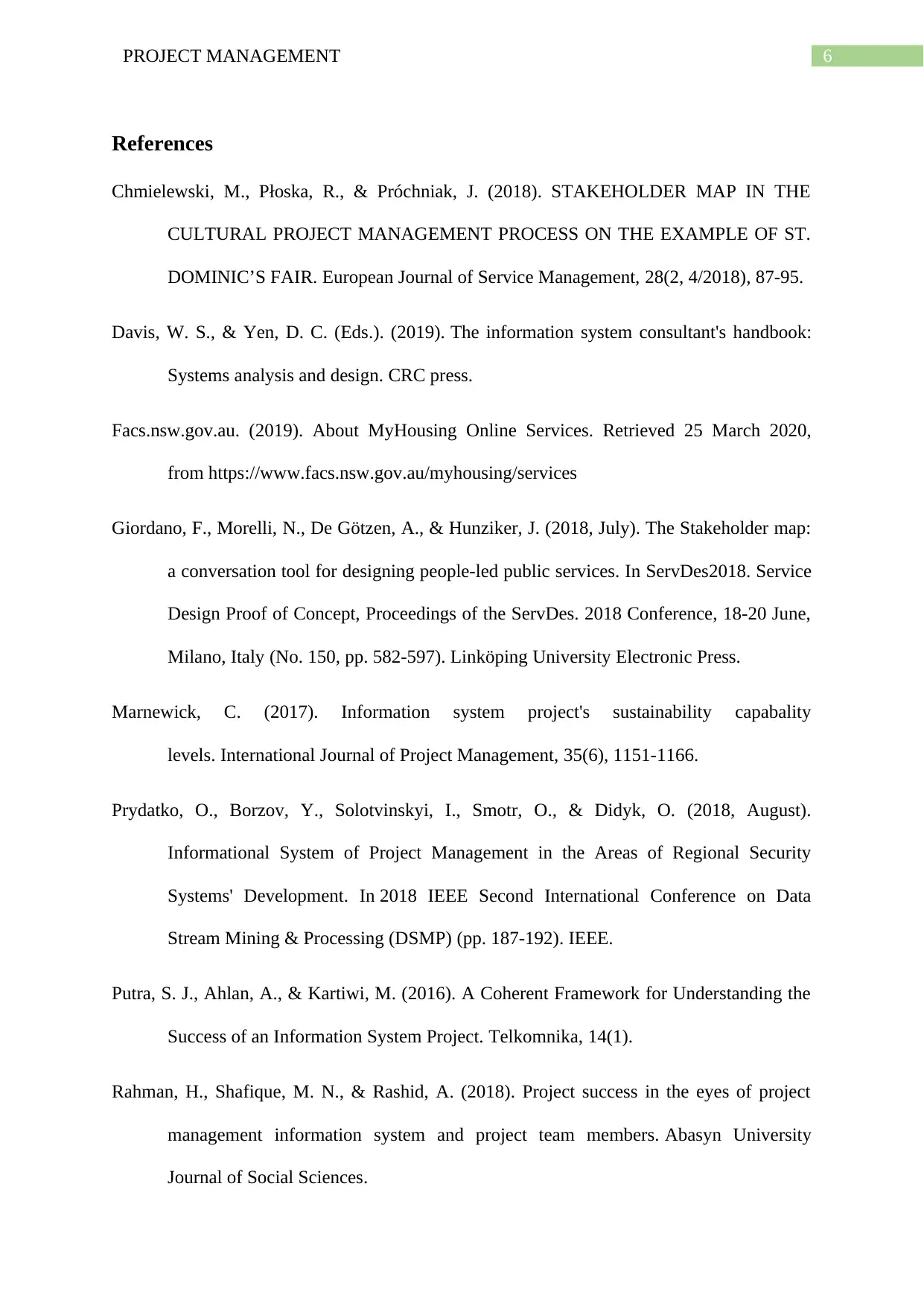
6PROJECT MANAGEMENT
References
Chmielewski, M., Płoska, R., & Próchniak, J. (2018). STAKEHOLDER MAP IN THE
CULTURAL PROJECT MANAGEMENT PROCESS ON THE EXAMPLE OF ST.
DOMINIC’S FAIR. European Journal of Service Management, 28(2, 4/2018), 87-95.
Davis, W. S., & Yen, D. C. (Eds.). (2019). The information system consultant's handbook:
Systems analysis and design. CRC press.
Facs.nsw.gov.au. (2019). About MyHousing Online Services. Retrieved 25 March 2020,
from https://www.facs.nsw.gov.au/myhousing/services
Giordano, F., Morelli, N., De Götzen, A., & Hunziker, J. (2018, July). The Stakeholder map:
a conversation tool for designing people-led public services. In ServDes2018. Service
Design Proof of Concept, Proceedings of the ServDes. 2018 Conference, 18-20 June,
Milano, Italy (No. 150, pp. 582-597). Linköping University Electronic Press.
Marnewick, C. (2017). Information system project's sustainability capabality
levels. International Journal of Project Management, 35(6), 1151-1166.
Prydatko, O., Borzov, Y., Solotvinskyi, I., Smotr, O., & Didyk, O. (2018, August).
Informational System of Project Management in the Areas of Regional Security
Systems' Development. In 2018 IEEE Second International Conference on Data
Stream Mining & Processing (DSMP) (pp. 187-192). IEEE.
Putra, S. J., Ahlan, A., & Kartiwi, M. (2016). A Coherent Framework for Understanding the
Success of an Information System Project. Telkomnika, 14(1).
Rahman, H., Shafique, M. N., & Rashid, A. (2018). Project success in the eyes of project
management information system and project team members. Abasyn University
Journal of Social Sciences.
References
Chmielewski, M., Płoska, R., & Próchniak, J. (2018). STAKEHOLDER MAP IN THE
CULTURAL PROJECT MANAGEMENT PROCESS ON THE EXAMPLE OF ST.
DOMINIC’S FAIR. European Journal of Service Management, 28(2, 4/2018), 87-95.
Davis, W. S., & Yen, D. C. (Eds.). (2019). The information system consultant's handbook:
Systems analysis and design. CRC press.
Facs.nsw.gov.au. (2019). About MyHousing Online Services. Retrieved 25 March 2020,
from https://www.facs.nsw.gov.au/myhousing/services
Giordano, F., Morelli, N., De Götzen, A., & Hunziker, J. (2018, July). The Stakeholder map:
a conversation tool for designing people-led public services. In ServDes2018. Service
Design Proof of Concept, Proceedings of the ServDes. 2018 Conference, 18-20 June,
Milano, Italy (No. 150, pp. 582-597). Linköping University Electronic Press.
Marnewick, C. (2017). Information system project's sustainability capabality
levels. International Journal of Project Management, 35(6), 1151-1166.
Prydatko, O., Borzov, Y., Solotvinskyi, I., Smotr, O., & Didyk, O. (2018, August).
Informational System of Project Management in the Areas of Regional Security
Systems' Development. In 2018 IEEE Second International Conference on Data
Stream Mining & Processing (DSMP) (pp. 187-192). IEEE.
Putra, S. J., Ahlan, A., & Kartiwi, M. (2016). A Coherent Framework for Understanding the
Success of an Information System Project. Telkomnika, 14(1).
Rahman, H., Shafique, M. N., & Rashid, A. (2018). Project success in the eyes of project
management information system and project team members. Abasyn University
Journal of Social Sciences.
Paraphrase This Document
Need a fresh take? Get an instant paraphrase of this document with our AI Paraphraser
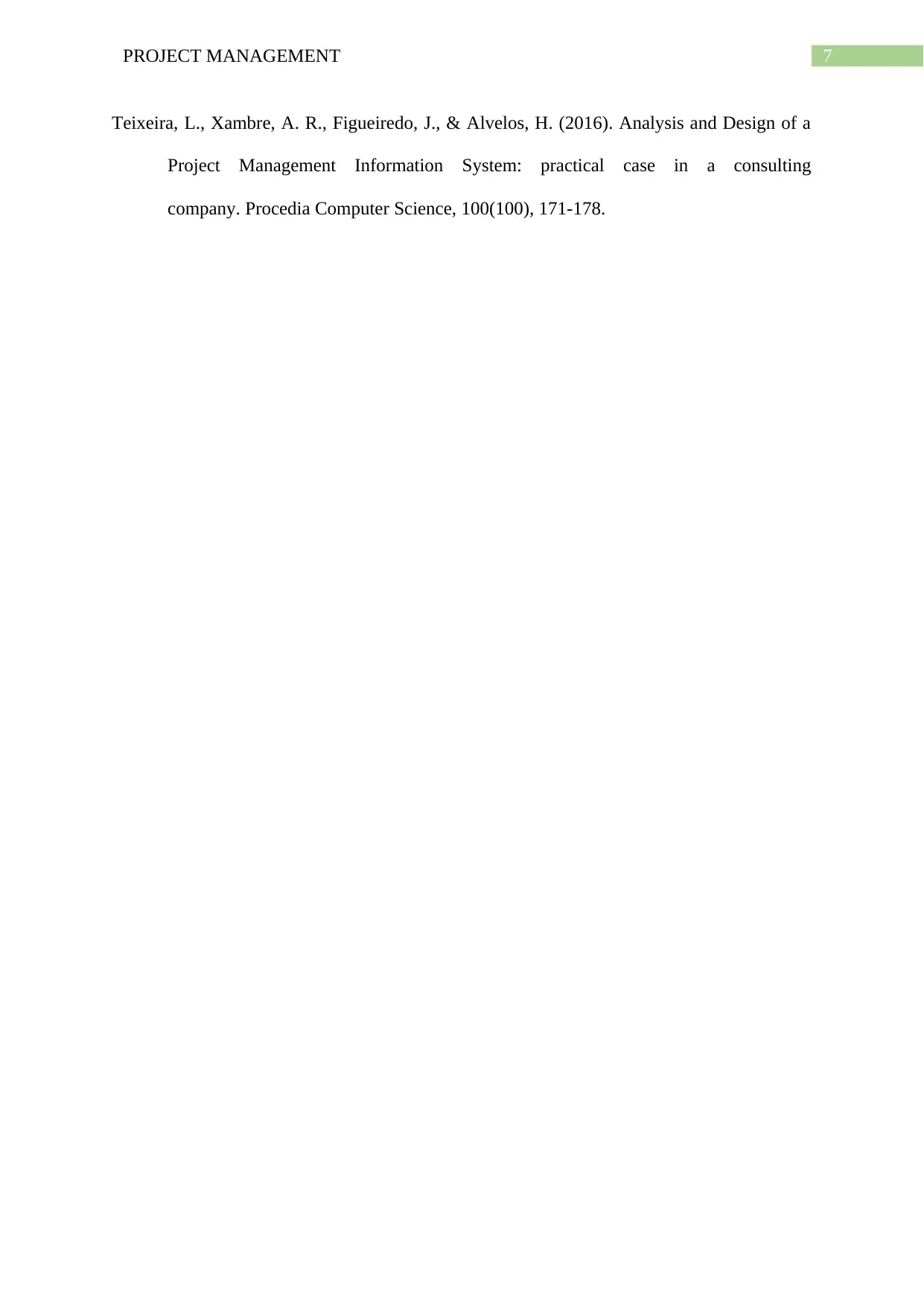
7PROJECT MANAGEMENT
Teixeira, L., Xambre, A. R., Figueiredo, J., & Alvelos, H. (2016). Analysis and Design of a
Project Management Information System: practical case in a consulting
company. Procedia Computer Science, 100(100), 171-178.
Teixeira, L., Xambre, A. R., Figueiredo, J., & Alvelos, H. (2016). Analysis and Design of a
Project Management Information System: practical case in a consulting
company. Procedia Computer Science, 100(100), 171-178.
1 out of 8
Related Documents
Your All-in-One AI-Powered Toolkit for Academic Success.
+13062052269
info@desklib.com
Available 24*7 on WhatsApp / Email
![[object Object]](/_next/static/media/star-bottom.7253800d.svg)
Unlock your academic potential
Copyright © 2020–2025 A2Z Services. All Rights Reserved. Developed and managed by ZUCOL.





